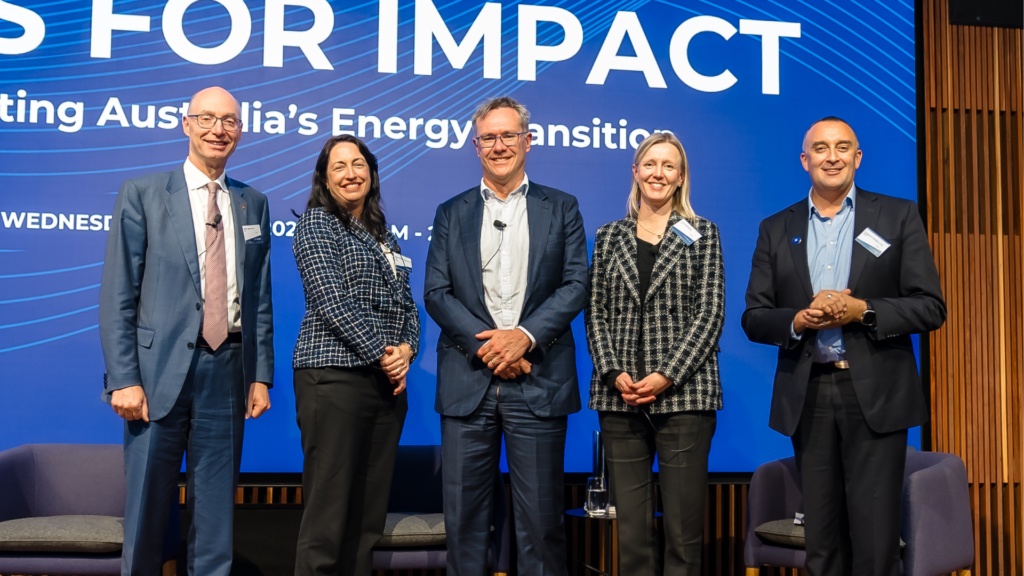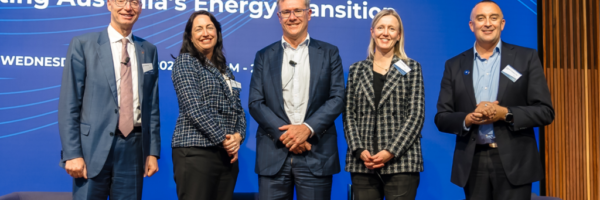
Building the renewable energy sector’s capacity, transitioning hard-to-abate sectors to green energy and finalising a sustainable finance taxonomy are three of the banking and finance sector’s priorities as the transition away from fossil fuels gathers pace.
These were some of the central messages delivered by panellists who took part in the first instalment of new thought leadership forum, FINSIA presents: Ideas for Impact held in April in Melbourne. This series brings together influential business leaders to discuss big issues and capital’s role solving them. At the inaugural event, three senior members of the financial services sector joined a panel session hosted by PwC Australia partner Fiona McIntyre to discuss how they are driving change during Australia’s energy transition.
Commenting on the opportunities and challenges around the move to net-zero carbon emissions, Dr Guy Debelle, an adviser to the Australian Retirement Trust’s investment committee, said electrification will be the decarbonisation solution for about 80 per cent of Australian businesses.
“But this requires that the [energy] grid is green. So, the fundamental challenge is enough renewable generation. We need a lot more capacity than we have in place currently,” he explained.
The $240 billion Australian Retirement Trust (ART), which has 2.3 million members, has a target of a 43 per cent reduction in carbon intensity by 2030. Debelle told the audience achieving ambitious targets such as this one requires more than just managing the portfolio’s carbon footprint.
“It’s about taking active steps to then invest into solutions to get you [to net zero],” said Debelle, who is co-chair of the Australian Sustainable Finance Institute’s Taxonomy Technical Expert Group. The group, of which ART is a member, is developing an Australian sustainable finance taxonomy.
For HESTA’s chief investment officer, Sonya Sawtell-Rickson SF FIN, the fact renewable energy pricing is very competitive means there’s a genuine economic reason for the fund to invest in renewable energy.
With $83 billion in funds under management, Hesta represents more than a million Australians, primarily from the health and community services sector. The fund invests in renewable energy and private equity investments in new battery technologies, as well as listed companies, such as electric vehicle manufacturers, that are meaningfully contributing to the transition to a low-carbon economy.
“Our purpose is to invest in and for people who make the world better, which
leads us to think a lot about climate change. The fund has been a very early advocate for an orderly, just and timely climate transition,” says Sawtell-Rickson.
HESTA was one of the first local funds to set a net-zero target for 2050 and an interim net-zero target for 2030, which it beat. It also aims to invest 10 per cent of its portfolio in climate solutions, to help accelerate the transition to renewable energy.
“Our philosophy is we don’t just need to decarbonise our portfolio, we need to decarbonise the economy,” says Sawtell-Rickson.
This involves actively engaging with its portfolio companies, as well as fund managers, infrastructure managers and property managers. “We want to see them really aligning with a net-zero pathway,” says Sawtell-Rickson.
She acknowledged a clear, cost-effective plan for hard-to-abate sectors to transition away from fossil fuels is still emerging and the commercial viability of technologies such as green hydrogen as a potential solution for these sectors is yet to be proven. Nevertheless, the time to act is now.
“If we accelerate our transition [to green energy], decarbonise the grid and electrify what we can, we have time to think through and solve [climate challenges] for those harder-to-abate sectors in a world that is still consistent with a one-and-a-half-degree pathway. So, that’s how we’re thinking about trying to put capital to work,” says Sawtell-Rickson, referring to Australia and many nations’ commitment to keep global temperatures below two degrees Celsius of pre-industrial levels.
In alliance with his fellow panellists, David Gall SF FIN, group executive, corporate and institutional banking, NAB, said the bank’s focus is to support clients through the transition to net zero, particularly those operating in high-emitting sectors.
NAB analysis indicates of around 100 high carbon-emitting clients across eight sectors, about 70 per cent have net-zero commitments in place. The bank is working with clients to understand their strategies and how they fit with commitments NAB has made under the Net-Zero Banking Alliance.
Gall agreed the economic opportunity of achieving net zero is substantial, with NAB’s figures indicating an economic uplift $435 billion by 2050 by transitioning to renewable energy.
“So the economic opportunity of getting it right is well worth it,” he said.
Gall acknowledged there are challenges to address on the path to net zero. This includes securing project approvals and planning in a way that’s sympathetic to the land holders whose assets will be required to support the transition away from fossil fuels, for instance by hosting solar and wind farms.
“We need 39 gigawatts of new renewable energy by 2030 and 10 gigawatts of storage. The more challenging bit’s going to be the 5,000 kilometres of transmission lines [we need], with capex exceeding $100 billion. But the projects are there and the money is there,” he says.
Panellists noted presently, the potential supply of capital for renewable energy projects is greater than the demand for finance from investable projects, given the long-lead time for project approvals.
It’s understood the federal government is working towards addressing the long lead times renewable energy projects experience. This year’s federal budget may involve announcements about ways to hasten renewable energy project approvals.
Looking ahead, a key milestone will be the development of Australia’s new sustainable finance taxonomy, with the focus currently on developing definitions for green finance and transition finance. Once finalised, the taxonomy will help regulators to assess greenhouse gas emitters’ material for greenwashing.
“The idea is to guide capital to where it needs to be,” says Debelle.
